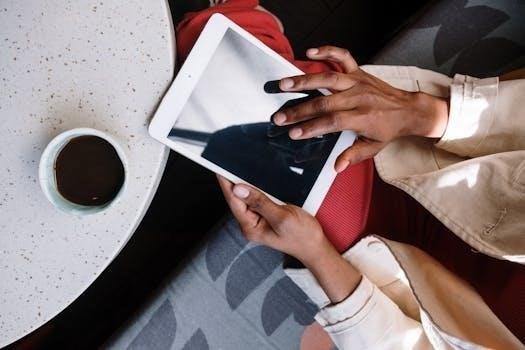Libras‚ the Brazilian Sign Language‚ is a vital communication tool for the Deaf community. Recognized as an official language‚ it plays a crucial role in social inclusion and access to information. Its rich structure and unique visual-spatial nature set it apart from spoken languages.
What is Libras?
Libras‚ or Brazilian Sign Language‚ is a visual-spatial language used by the Deaf community in Brazil. It’s not simply a translation of Portuguese into signs; rather‚ it possesses its own unique grammar‚ vocabulary‚ and structure. Unlike spoken languages that rely on auditory perception‚ Libras utilizes handshapes‚ facial expressions‚ body movements‚ and spatial orientation to convey meaning. It’s a dynamic and expressive language‚ crucial for communication‚ education‚ and cultural identity within the Deaf community. Libras has been recognized as an official language of Brazil‚ highlighting its importance and ensuring the rights of Deaf individuals to use their native language. The language is rich and complex‚ it also involves the use of classifiers‚ which are handshapes that represent categories of objects or beings‚ and incorporates various regional variations. Learning Libras is not only about memorizing signs; it is also about understanding the culture and perspective of the Deaf community in Brazil. The language is a complete form of communication. It enables full and effective interaction.
Libras as an Official Language of Brazil
Libras‚ the Brazilian Sign Language‚ gained official recognition as a language in Brazil through Law 10.436‚ enacted in 2002. This landmark legislation marked a significant step forward for the Deaf community‚ acknowledging Libras as a legitimate means of communication and expression. This official status ensures the Deaf community has the right to use Libras in all spheres of life‚ including education‚ employment‚ and legal contexts. The recognition of Libras as an official language also underscores its importance as a vital part of Brazilian culture‚ not just a tool for communication. This law mandates the inclusion of Libras in educational settings and promotes the development of resources‚ such as dictionaries and teaching materials‚ to support its learning and use. Furthermore‚ the law encourages the use of Libras in public services‚ accessibility in media‚ and overall awareness of the language to foster a more inclusive and equitable society. It solidifies Libras as a complete language system with its own rules and nuances‚ deserving of respect and recognition on par with spoken languages.

Learning Resources for Libras
Numerous resources are available for learning Libras‚ including PDF materials‚ dictionaries‚ and online courses. These materials provide diverse learning pathways‚ supporting both beginners and advanced learners in their journey to master Libras.
PDF Materials for Libras Learning

PDF materials offer a convenient and accessible way to begin learning Libras. Many institutions and educational platforms provide free downloadable PDF documents with introductions to basic signs‚ grammar‚ and cultural insights. These materials can include alphabet charts‚ common phrases‚ and vocabulary lists. Some PDFs may focus on specific themes‚ such as family‚ food‚ or daily activities. They often utilize illustrations and diagrams to make the visual nature of Libras easier to grasp.
Additionally‚ PDF resources might incorporate exercises and quizzes to reinforce learning. These materials are ideal for self-study or as supplementary resources in formal learning settings. They can be easily printed or used on digital devices‚ making them flexible for diverse learning environments. It’s important to seek out reputable sources to ensure the accuracy and quality of the content‚ and to pair these materials with practice and interaction with the Libras community for effective learning.
Look for PDF materials that offer clear visual representations and accurate information‚ ensuring a solid foundation in Libras.
Libras Dictionaries and Glossaries
Libras dictionaries and glossaries are essential tools for language learners‚ offering comprehensive collections of signs and their corresponding meanings. Unlike traditional dictionaries‚ Libras dictionaries often incorporate visual elements like illustrations or videos to demonstrate the precise handshapes‚ movements‚ and facial expressions that constitute each sign. These resources can be found in both print and digital formats‚ with many available as downloadable PDFs.
Glossaries may focus on specific fields‚ such as education‚ healthcare‚ or law‚ providing specialized vocabulary. When using these resources‚ it’s important to pay attention to the various parameters of a sign‚ including handshape‚ location‚ movement‚ and palm orientation. A good Libras dictionary should also include regional variations‚ as signs can differ across Brazil. These reference materials are invaluable for expanding vocabulary and enhancing understanding of the language. They are beneficial for both beginners and advanced learners‚ enabling effective communication in Libras.
Utilizing both dictionaries and glossaries will support a richer learning experience and proficiency.
Online Courses and Tutorials for Libras
The digital landscape offers a wealth of online courses and tutorials for learning Libras‚ catering to various skill levels and learning styles. Many platforms provide structured courses‚ often featuring video lessons‚ interactive exercises‚ and quizzes to reinforce learning. These resources make it easier for individuals to learn at their own pace‚ anytime and anywhere. These courses often use PDF materials as supplementary learning tools‚ which can provide additional vocabulary lists and exercises.
Tutorials‚ on the other hand‚ may focus on specific aspects of Libras‚ such as grammar‚ classifiers‚ or regional variations. Some online platforms offer a hybrid approach‚ combining structured courses with live online classes for a more personalized learning experience. These platforms often incorporate visual aids effectively‚ which is crucial for sign language acquisition. Many free resources are available‚ offering an accessible entry point for beginners‚ while paid courses often provide more in-depth instruction and personalized feedback.
When selecting an online course or tutorial‚ it is important to consider the instructor’s qualifications and the platform’s reputation. This will help in ensuring a quality learning experience.

The Structure and Nuances of Libras
Libras‚ as a visual-spatial language‚ differs significantly from spoken languages. It utilizes handshapes‚ movements‚ facial expressions‚ and body orientation to convey meaning‚ exhibiting unique grammatical structures and regional variations.
Visual-Spatial Nature of Libras
Libras‚ unlike spoken languages‚ is fundamentally visual and spatial. This means that communication relies heavily on the visual perception of signs‚ their movement‚ and their location in space‚ as well as facial expressions and body language. It’s not just about the hands; the entire body participates in conveying meaning. The space around the signer becomes an active part of the language‚ used to indicate relationships between objects‚ actions‚ and time. The visual-spatial nature of Libras allows for a unique way of expressing complex ideas and concepts. For instance‚ spatial placement can demonstrate the location of objects or characters in a narrative. The use of space also allows for simultaneous communication‚ where multiple aspects of a message can be conveyed at the same time. This contrasts sharply with the linear nature of spoken languages‚ where words are typically presented in a sequence. Understanding this visual-spatial aspect is crucial for comprehending the richness and expressiveness of Libras and its grammar.
Variations in Libras
Like any living language‚ Libras exhibits variations across different regions‚ social groups‚ and even historical periods. These variations can be seen in the signs themselves‚ their usage‚ and the grammatical structures employed. Regional dialects in Libras exist due to the decentralized development of the language in various Deaf communities across Brazil. Factors like geographic isolation and unique community experiences contribute to these variations. Social factors‚ such as age‚ education level‚ and cultural background‚ also play a role in shaping how Libras is used. Moreover‚ the language has evolved over time‚ with some older signs being replaced or modified by newer ones. These variations are not considered errors but rather natural occurrences that enrich the diversity of Libras. Understanding the existence of variations is crucial for effective communication and for appreciating the dynamic nature of the language. While a core set of signs and grammatical rules are widely shared‚ recognizing and adapting to variations is important for fluent communication.
Classifiers in Libras
Classifiers in Libras are a unique feature of the language‚ utilizing handshapes to represent objects‚ people‚ and their movements. These handshapes function as a type of visual pronoun‚ conveying information about the shape‚ size‚ and spatial relationships of referents. Rather than using a single sign for a noun‚ classifiers allow for a more descriptive and visually engaging way to represent entities. For example‚ a specific handshape might represent a car‚ while another may indicate a person. The movement of these handshapes then conveys actions and their spatial relationship to other entities. This system creates a dynamic and expressive form of communication‚ as classifiers can show not only what is present‚ but also how it is being used or how it is moving. These classifiers are an integral part of the language‚ contributing to its rich visual-spatial nature. Mastery of classifiers is essential for fluent communication in Libras‚ allowing for a more nuanced and specific way of conveying information through visual representation.

Libras in Education and Inclusion
Libras plays a pivotal role in inclusive education‚ serving as a primary communication tool for deaf students. It fosters interaction between students and teachers and among peers‚ ensuring accessibility and equal opportunities within the educational environment.
Libras in Inclusive Education
The integration of Libras into inclusive educational settings is paramount for fostering a supportive and equitable learning environment for deaf students. As the official language of the Brazilian Deaf community‚ Libras serves as their primary mode of communication‚ ensuring access to curriculum content and facilitating meaningful interactions with peers and educators. The use of Libras transcends mere translation; it is about creating an immersive and culturally relevant experience for deaf learners. By utilizing Libras‚ educators enable deaf students to actively participate in classroom discussions‚ express their ideas‚ and build a strong sense of identity. Furthermore‚ the inclusion of Libras in education promotes a more diverse and accepting atmosphere for all students‚ fostering understanding and respect for linguistic and cultural differences. This approach is not only beneficial for deaf learners but enriches the educational experience for their hearing peers‚ creating a more inclusive and harmonious school environment. The implementation of Libras in inclusive education requires specialized training for educators and the provision of appropriate resources‚ such as Libras dictionaries and visual aids‚ to ensure effective communication and learning outcomes for all students.
Libras as a Tool for Communication
Libras‚ as a visual-spatial language‚ serves as an essential communication tool for the Deaf community in Brazil‚ enabling interaction and expression within a rich linguistic framework. Beyond basic communication‚ Libras facilitates intricate dialogues‚ conveying abstract concepts and nuanced emotions. The language’s structure‚ utilizing handshapes‚ movements‚ facial expressions‚ and body postures‚ allows for a full range of expression. Its visual nature provides a direct and accessible mode of communication for those who cannot rely on auditory information. The use of Libras also contributes to the development of cognitive skills‚ such as spatial reasoning and visual processing. As a distinct language with its own grammar and syntax‚ Libras is not merely a translation of spoken Portuguese; it’s a fully developed language that fosters a sense of community and identity among its users. The ability to communicate effectively through Libras is crucial for deaf individuals to participate fully in society‚ access education‚ and engage in social and professional settings. Its recognition as an official language underscores its importance as a vital mode of communication within Brazil.
Libras and Accessibility
Libras is paramount for accessibility‚ ensuring that Deaf individuals have equal opportunities to participate in all aspects of society. The presence of Libras interpreters in public services‚ education‚ healthcare‚ and media is crucial for removing communication barriers and promoting inclusivity. Accessibility through Libras extends to various digital platforms‚ with efforts to create sign language versions of online content‚ making information available to the Deaf community. Furthermore‚ providing educational materials and resources in Libras enhances learning opportunities for Deaf students. The use of Libras in professional settings is also essential for creating inclusive workplaces where Deaf employees can communicate effectively with colleagues. By recognizing Libras as a primary language‚ Brazil is taking steps to foster a more equitable environment where Deaf individuals can access and contribute to society on equal terms. Accessibility‚ in this context‚ means more than just physical access; it implies the removal of communication barriers through the widespread use and recognition of Libras. This results in increased participation in community life‚ education‚ and the workforce.
